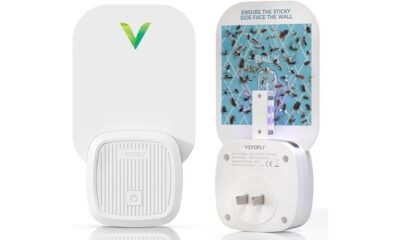Beginners Guides
How Long Does a Landlord Have to Fix a Furnace

Let’s be honest – when the furnace stops working, it can make us feel like we are left out in the cold.
But what happens when the responsibility to fix it falls on the landlord? How long do they have to get that warmth flowing again?
Well, it's not as straightforward as we might hope, and there are some important factors to consider.
In this discussion, we'll break down the legal obligations and timelines for addressing furnace issues, as well as the consequences of delayed maintenance.
Understanding the tenant's rights and the landlord's responsibilities in this situation is crucial, so stick around to get the full picture.
Key Takeaways
- Landlords are responsible for maintaining and repairing the furnace in a rental property.
- Tenants have the right to formally request repairs in writing and may be able to withhold rent or deduct repair costs.
- If the landlord fails to address furnace issues, tenants have the option to file a complaint with the local housing authority or take legal action as a last resort.
- It is important for landlords to adhere to timelines for addressing furnace issues to ensure tenant well-being, rental property habitability, and to avoid negative consequences such as tenant dissatisfaction, increased energy costs, property damage, health risks, and legal liabilities.
Legal Obligations for Furnace Repairs
The landlord is legally responsible for ensuring that the furnace in a rental property is properly maintained and promptly repaired as needed. When it comes to the tenant's options for addressing a faulty furnace, it's important to understand the legal recourse available.
If the landlord fails to address the furnace issues, tenants have several options. Firstly, they can formally request repairs in writing, ensuring to keep a copy for their records. If the landlord still doesn't address the problem, tenants may have the right to withhold rent or deduct the cost of repairs from the rent, but this varies by jurisdiction, so tenants should review local laws.
Another option is to file a complaint with the local housing authority or take legal action. Tenants should always document all communication with the landlord regarding the furnace issues and keep records of any expenses related to temporary heating solutions or repairs.
Before taking any action, tenants should seek legal advice to understand their rights and the best course of action.
Timeline for Addressing Furnace Issues

Promptly addressing furnace issues is crucial to ensure the comfort and safety of tenants in a rental property. When a furnace issue is reported, a landlord should conduct a thorough furnace inspection to assess the problem.
This inspection should ideally take place within 24 to 48 hours of the issue being reported. Once the problem has been identified, the landlord should prioritize the necessary repairs.
Emergency repairs, such as those related to a lack of heat in cold weather, should be addressed as a matter of urgency, typically within 24 hours. For non-emergency issues, the repairs should be completed within a reasonable timeframe depending on the severity of the problem.
Landlords should communicate the timeline for repairs clearly to the tenants and keep them updated on any delays or changes to the schedule. It's essential to adhere to these timelines to ensure the well-being of the tenants and maintain the habitability of the rental property.
Consequences of Delayed Furnace Maintenance
Addressing furnace maintenance delays can lead to increased discomfort and potential safety hazards for tenants in a rental property.
When furnace maintenance is delayed, several consequences may arise, including:
- Tenant Dissatisfaction: Delayed furnace maintenance can lead to tenant dissatisfaction, resulting in negative reviews, decreased tenant retention, and difficulty finding new tenants.
- Increased Energy Costs: A poorly maintained furnace may operate less efficiently, leading to increased energy consumption and higher utility bills for both the landlord and the tenants.
- Property Damage: Lack of timely furnace maintenance can result in damage to the property, such as frozen or burst pipes, which can be costly to repair and may lead to insurance claims.
- Health Risks: A malfunctioning furnace can pose health risks to tenants, including exposure to carbon monoxide or indoor air quality issues.
- Legal Issues: Failure to promptly address furnace maintenance issues can lead to legal liabilities for the landlord, including potential lawsuits from tenants for negligence.
Tenant's Rights Regarding Furnace Fixes
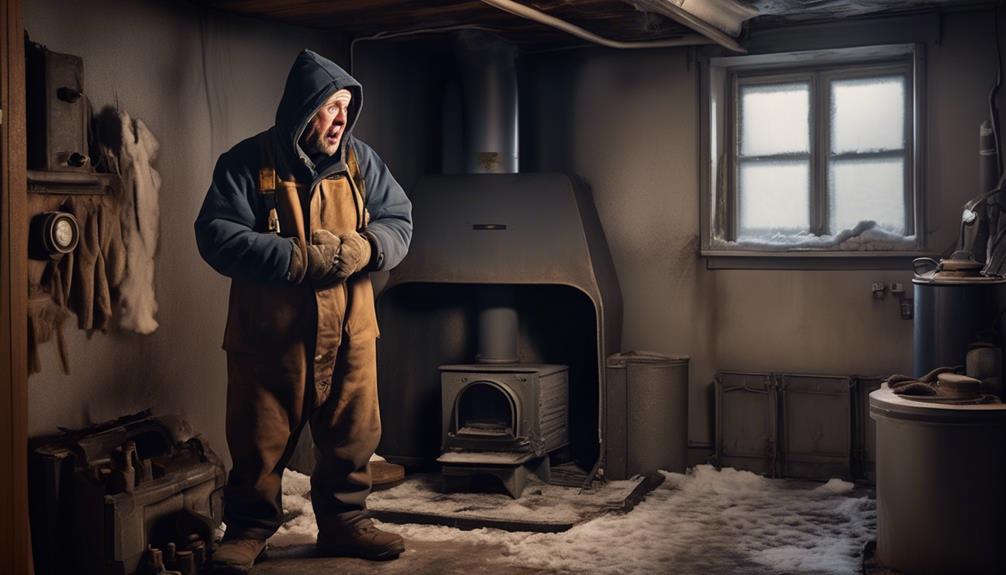
After discussing the consequences of delayed furnace maintenance, it is important to understand the tenant's rights regarding furnace fixes in a rental property. As a tenant, it's crucial to be aware of your rights when it comes to ensuring a properly functioning furnace in your rental unit. Here's a breakdown of tenant's recourse and repair reimbursement:
| Tenant's Recourse | Repair Reimbursement |
|---|---|
| Notify the Landlord | Request for reimbursement if the repair is due to normal wear and tear, and not caused by tenant negligence. |
| Written Request | Keep records of all communication with the landlord regarding the furnace issue. |
| Allow Reasonable Time | If the landlord fails to address the issue within a reasonable time frame, tenants may have the right to withhold rent or request a repair and deduct the cost from the rent. |
| Legal Action | As a last resort, tenants have the right to take legal action to enforce repair obligations if the landlord continues to neglect the furnace issues. |
| Tenant's Responsibilities | Tenants are responsible for maintaining the furnace by changing filters and promptly reporting any issues to prevent further damage. |
Understanding your rights as a tenant regarding furnace fixes empowers you to take appropriate action and ensures a habitable living environment.
Landlord's Responsibilities for Furnace Repairs
The landlord is responsible for ensuring the proper functioning of the furnace in a rental property. As part of the landlord's liability and the need for proper maintenance, the following key responsibilities are essential:
- Regular Inspections: The landlord should conduct regular inspections of the furnace to ensure it's in good working condition and address any issues promptly.
- Timely Repairs: Any necessary repairs or maintenance should be carried out in a timely manner to prevent further damage or inconvenience to the tenants.
- Providing Documentation: The landlord should keep documentation of all maintenance and repairs conducted on the furnace for transparency and record-keeping purposes.
- Ensuring Safety: It's the landlord's responsibility to ensure that the furnace operates safely and meets all required safety standards to protect the tenants.
- Professional Maintenance: Engaging qualified professionals for regular maintenance and servicing of the furnace is crucial to ensure its longevity and efficient operation.
These responsibilities underscore the importance of the landlord's proactive approach in maintaining a safe and functional furnace within the rental property.
Frequently Asked Questions
Can a Tenant Fix the Furnace Themselves and Deduct the Cost From Their Rent if the Landlord Takes Too Long to Address the Issue?
Yes, according to tenant's rights, DIY repairs are a viable option if the landlord delays fixing the furnace.
However, it's crucial to follow legal procedures and notify the landlord beforehand. Document the issue and the repair costs.
After the landlord's reasonable time to fix it has passed, deduct the cost from the rent. Keep records and receipts for transparency.
Consult local laws and regulations to ensure compliance with tenant's rights.
What Are the Common Signs That Indicate a Furnace Needs Maintenance or Repair?
Signs of furnace issues include strange noises, uneven heating, increased energy bills, and frequent cycling.
Regular maintenance is crucial to prevent problems. Landlords are responsible for ensuring furnaces are in working condition, addressing issues promptly.
Tenants have rights to habitable living conditions and can request repairs. It's important to understand the responsibilities and rights regarding furnace maintenance and repair to ensure a comfortable living environment.
Is the Landlord Responsible for Providing Space Heaters or Alternative Heating Options if the Furnace Cannot Be Fixed Immediately?
Absolutely, as per tenant rights, the landlord is responsible for providing alternative heating options if the furnace can't be fixed immediately. This falls under the landlord's obligations to ensure habitable living conditions.
Additionally, compensation may be sought for the inconvenience caused.
It's crucial for landlords to understand the importance of promptly addressing heating issues and providing suitable alternatives to ensure tenant comfort and safety.
Can a Tenant Terminate Their Lease or Withhold Rent if the Furnace Is Not Fixed Within a Certain Time Frame?
If a landlord fails to fix a furnace within a reasonable time frame, tenant rights may include legal options such as terminating the lease or withholding rent.
However, the specific time frame for taking these actions can vary based on local laws and the terms of the lease agreement.
It's crucial for tenants to understand their rights and obligations under the law and their lease before pursuing such actions.
Are There Any Specific Regulations or Laws Regarding Furnace Repairs and Maintenance in Different States or Regions?
State regulations dictate landlord obligations regarding furnace repairs and maintenance. It's crucial to be aware of these laws to ensure compliance and protect tenants' rights.
Understanding the specific requirements in different states or regions is essential for landlords to fulfill their responsibilities and for tenants to know their rights.
Staying informed about these regulations can prevent potential conflicts and ensure a safe and habitable living environment for all parties involved.
– How Can I Secure the Furnace Closet While Waiting for the Landlord to Fix the Furnace?
If you’re waiting for the landlord to fix the furnace, securing the furnace closet doors should be a top priority. You can use a strong padlock or latch to prevent unauthorized access. Additionally, consider adding a temporary barrier like a safety gate or barricade to keep the area safe until the repairs are made.
Conclusion
In conclusion, it's important for landlords to promptly address furnace issues in order to comply with legal obligations and ensure the comfort and safety of their tenants.
Delayed furnace maintenance can lead to costly consequences and potential legal action.
As the saying goes, 'a stitch in time saves nine,' so it's crucial for landlords to fulfill their responsibilities and promptly fix any furnace problems to maintain a harmonious landlord-tenant relationship.
- About the Author
- Latest Posts
Introducing Ron, the home decor aficionado at ByRetreat, whose passion for creating beautiful and inviting spaces is at the heart of his work. With his deep knowledge of home decor and his innate sense of style, Ron brings a wealth of expertise and a keen eye for detail to the ByRetreat team.
Ron’s love for home decor goes beyond aesthetics; he understands that our surroundings play a significant role in our overall well-being and productivity. With this in mind, Ron is dedicated to transforming remote workspaces into havens of comfort, functionality, and beauty.
Beginners Guides
Electric Griddle Temperature for Pancakes
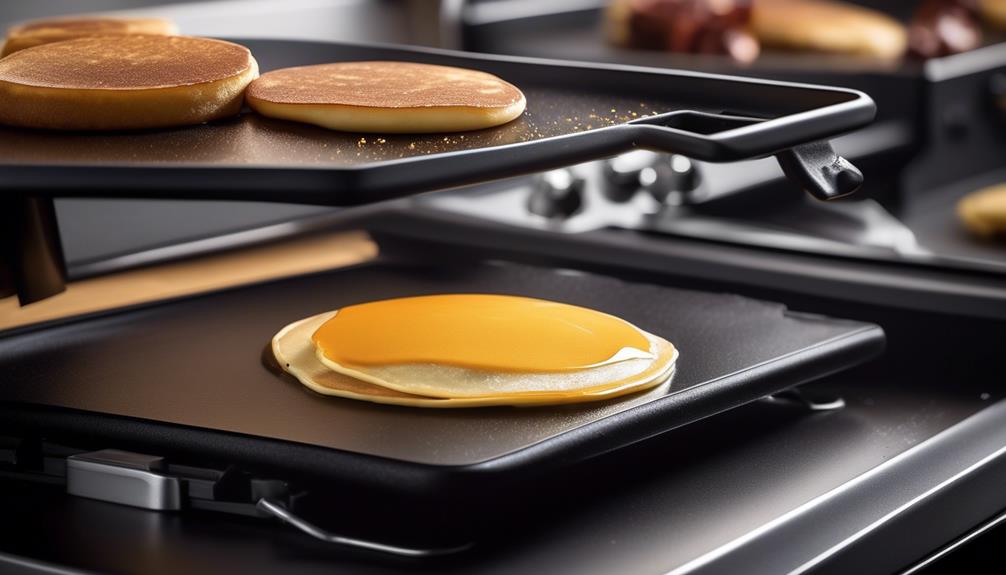
When cooking pancakes on an electric griddle, getting the temperature just right is crucial. If it’s too high, you run the risk of burning the outside and leaving the inside uncooked. If it’s too low, you’ll end up with pale, rubbery pancakes.
Temperature control is crucial for achieving the perfect pancake texture and flavor. As a professional chef, we've spent countless hours experimenting with different temperatures to perfect the art of pancake-making on an electric griddle.
But before we reveal the optimal temperature range, let's discuss why temperature control is crucial for achieving the perfect pancake texture and flavor.
Key Takeaways
- Maintaining correct temperature on electric griddle is crucial for fluffy, evenly cooked pancakes
- Achieving optimal temperature range is essential for perfect pancakes of different types
- Incorrect temperatures result in undercooked or overcooked pancakes, with burnt or rubbery texture
- Testing griddle temperature by sprinkling water and adjusting temperature accordingly ensures perfect results for each pancake
Importance of Temperature Control
Maintaining the correct temperature on an electric griddle is crucial for achieving perfectly fluffy and evenly cooked pancakes. Temperature consistency is key to ensuring that the pancakes cook evenly and don't end up burnt or undercooked. To achieve this, it's essential to preheat the electric griddle to the correct temperature and maintain it throughout the cooking process.
The ideal temperature for cooking pancakes on an electric griddle is around 375°F. This temperature allows the pancakes to cook through without burning on the outside.
When it comes to cooking techniques, using a consistent temperature enables us to employ various cooking methods to achieve different textures and flavors. For example, cooking pancakes at a slightly lower temperature results in a more even, golden-brown color, while a slightly higher temperature can create a slightly crispier exterior. Additionally, maintaining a consistent temperature allows for better control over the cooking process, ensuring that the pancakes are cooked to perfection each time.
Mastering the art of temperature control and cooking techniques on an electric griddle is essential for achieving the perfect pancakes.
Optimal Temperature Range
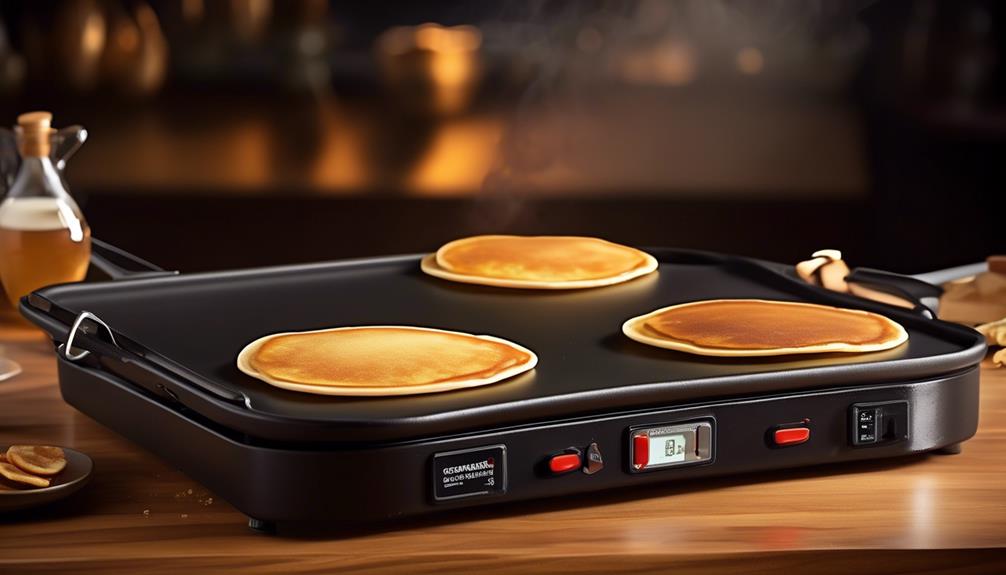
We find that achieving the optimal temperature range on the electric griddle is essential for consistently perfect pancakes. Cooking techniques and recipe variations can significantly impact the ideal temperature for pancake preparation. The table below outlines the optimal temperature range for cooking pancakes on an electric griddle, as well as some variations to consider for different pancake types.
| Pancake Type | Ideal Temperature Range | Cooking Techniques |
|---|---|---|
| Buttermilk | 375°F – 385°F | Pour batter in small circles and wait for bubbles to form before flipping. |
| Blueberry | 365°F – 375°F | Use lower heat to prevent berries from burning, flip when the edges look set. |
| Chocolate Chip | 355°F – 365°F | Cook at a slightly lower temperature to avoid scorching the chocolate chips. |
| Whole Wheat | 375°F – 385°F | Cook at a slightly higher heat to ensure thorough cooking of denser batter. |
| Vegan | 355°F – 365°F | Use a lower temperature to allow the batter to cook through without burning. |
Experimenting with different temperature ranges and cooking techniques based on the pancake type can help achieve the perfect texture and flavor for each recipe variation.
Effects of Incorrect Temperatures
When the temperature is incorrect, pancakes can either turn out undercooked in the center or overcooked and dry around the edges. Overheating the griddle can lead to pancakes cooking too quickly on the outside while the inside remains raw. This results in a gooey, unappetizing texture and an unevenly cooked pancake.
On the other hand, underheating the griddle can cause the batter to spread too much before setting, resulting in thin, rubbery pancakes. The impact of underheating is also evident in the prolonged cooking time, leading to dry and tough pancakes due to excessive evaporation of moisture. Additionally, pancakes cooked at a lower temperature may absorb more grease or oil, making them excessively oily and less appetizing.
It's crucial to maintain the correct temperature to achieve that perfect golden-brown color and a light, fluffy texture throughout the pancake. Finding the optimal temperature for your electric griddle is essential to ensure that the pancakes are cooked evenly, with a delicate balance of moistness and fluffiness.
Tips for Testing Griddle Temperature
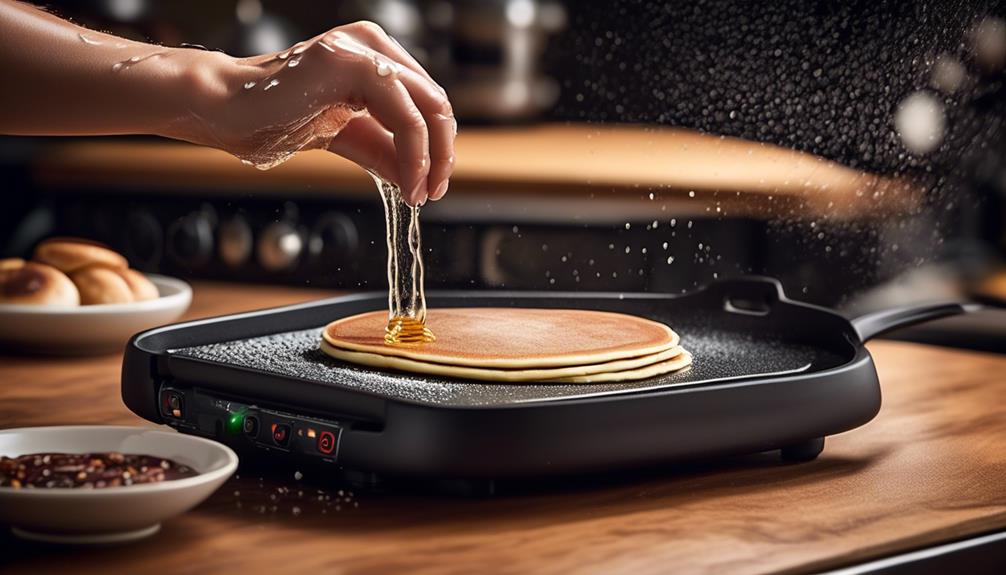
To ensure the griddle is at the right temperature, a simple test is to sprinkle a few drops of water onto the cooking surface and observe how they react. Here are some tips for testing griddle temperature:
- Even Heat Distribution: After preheating the griddle, sprinkle a few drops of water across the cooking surface. If the water droplets sizzle and evaporate evenly across the griddle, it indicates that the heat is evenly distributed, and the griddle is ready for cooking.
- Quick Reaction: The water droplets should sizzle upon contact and evaporate within a few seconds. This quick reaction indicates that the griddle is hot enough to cook pancakes evenly without burning them.
- Levelling the Surface: Before testing the temperature, ensure that the griddle is placed on a level surface to allow for even heat distribution and accurate testing.
- Consistency: Repeat the water droplet test in different areas of the griddle to ensure consistent heat distribution across the entire cooking surface.
Adjusting Temperature for Different Pancake Types
For optimal results when cooking various types of pancakes, adjusting the temperature of the electric griddle is essential. The texture and cooking time of pancakes vary depending on the type of batter and ingredients used.
When making fluffy buttermilk pancakes, set the griddle to a medium heat, around 350°F (175°C). This allows the pancakes to cook through evenly without burning while achieving a light and airy texture.
Thicker batters, such as those used for blueberry or chocolate chip pancakes, require a slightly lower temperature to ensure that the inside cooks fully without the outside becoming too dark. Adjust the griddle to a medium-low heat, approximately 325°F (163°C), to achieve the perfect balance.
For thinner and delicate pancakes like crepes, a low heat setting, around 275°F (135°C), is ideal. This lower temperature prevents overcooking and helps maintain a tender texture.
Additionally, adjusting the temperature based on the type of pancake batter used can affect the cooking time, ensuring that each pancake is perfectly cooked and delightful to eat.
Frequently Asked Questions
Can I Use an Electric Griddle for Pancakes if It Doesn't Have Temperature Control?
Yes, you can use an electric griddle for pancakes even if it doesn't have temperature control.
When it comes to griddle alternatives, a non-adjustable electric griddle can still produce delicious pancakes.
To ensure even cooking, preheat the griddle and test the temperature by sprinkling a few droplets of water.
As for pancake flipping techniques, use a spatula and wait for bubbles to form on the surface before flipping.
Are There Any Safety Concerns Related to Electric Griddle Temperatures for Making Pancakes?
When it comes to electric griddle safety, it's essential to understand the potential risks associated with improper temperature settings.
In pancake cooking, maintaining the right temperature is crucial to ensure they cook evenly and avoid burning.
It's important to be mindful of overheating the griddle, which can pose safety concerns.
Can I Use a Specific Type of Oil or Butter to Help Regulate the Griddle Temperature for Pancakes?
We can use a butter alternative to help regulate the griddle temperature for pancakes.
Additionally, the choice of oil can affect heat distribution on the griddle. It's important to select an oil with a high smoking point, like vegetable or canola oil, to maintain the desired cooking temperature.
This will help ensure even cooking and prevent the pancakes from burning.
How Do Different Altitudes Affect the Optimal Temperature for Cooking Pancakes on an Electric Griddle?
At high altitudes, the lower air pressure affects the optimal cooking temperature for pancakes on an electric griddle. The batter may need adjustments to maintain the desired pancake consistency.
Additionally, the cooking time could be slightly longer due to the altitude effects on heat transfer. It's essential to experiment and make slight modifications to the griddle temperature and cooking time to achieve perfect pancakes at different altitudes.
Are There Any Specific Temperature Adjustments Needed for Gluten-Free or Vegan Pancake Batter on an Electric Griddle?
We've found that specific temperature adjustments can be necessary for gluten-free or vegan pancake batter on an electric griddle. When dealing with altitude effects, temperature control becomes crucial to achieve the desired texture and flavor.
It's important to note that safety concerns should also be considered when making these adjustments. We've learned that fine-tuning the temperature settings for gluten-free or vegan pancake batter can lead to outstanding results.
What is the Ideal Temperature for Cooking Pancakes on an Electric Griddle?
The ideal pancake griddle temperature is around 375°F to 400°F. This allows the pancakes to cook evenly and develop a golden-brown color. A hotter griddle can result in uneven cooking and burnt pancakes, while a lower temperature can make them pale and doughy.
Conclusion
So, next time you're making pancakes on the electric griddle, remember that getting the temperature right is crucial for perfect pancakes.
It's no coincidence that the optimal temperature range ensures fluffy, golden-brown pancakes every time.
Keep an eye on the temperature and make any necessary adjustments to achieve the best results.
Happy flipping!
- About the Author
- Latest Posts
Introducing Ron, the home decor aficionado at ByRetreat, whose passion for creating beautiful and inviting spaces is at the heart of his work. With his deep knowledge of home decor and his innate sense of style, Ron brings a wealth of expertise and a keen eye for detail to the ByRetreat team.
Ron’s love for home decor goes beyond aesthetics; he understands that our surroundings play a significant role in our overall well-being and productivity. With this in mind, Ron is dedicated to transforming remote workspaces into havens of comfort, functionality, and beauty.
Beginners Guides
Top of Curtain Light Blocker

When it comes to achieving a peaceful and cozy vibe in our homes, we frequently face the difficulty of controlling natural light.
We've all experienced the frustration of too much sunlight streaming into a room, disrupting our relaxation or work environment.
This is where the top of curtain light blocker comes into play. It offers a subtle yet effective solution to control the amount of light entering a space.
But how do these light blockers work, and what should we consider when choosing one?
Stick around to find out how these simple yet ingenious devices can make a significant difference in our daily lives.
Key Takeaways
- Blocking out light creates a peaceful and relaxing environment
- Light blockers support optimal sleep quality by managing exposure to light
- Incorporating light blockers enhances the overall ambiance of living spaces
- Light-blocking curtains can be stylish and elegant, adding sophistication to a room
Importance of Light Blockers
Blocking out light is crucial for creating a peaceful and relaxing environment, allowing us to unwind and recharge without interruption. When it comes to ensuring optimal sleep quality, light blockers play a pivotal role.
Our bodies are naturally attuned to the cycle of light and dark, known as the circadian rhythm. By incorporating light-blocking curtains into our home decor, we can effectively manage our exposure to light, especially during the evening and early morning hours. This, in turn, promotes better sleep quality by signaling to our bodies that it's time to wind down and prepare for rest.
Incorporating light blockers into our home decor not only supports our sleep quality but also enhances the overall ambiance of our living spaces. The use of stylish and elegant light-blocking curtains not only serves a functional purpose but also adds a touch of sophistication to the room. By carefully selecting the right fabric, color, and design, we can seamlessly integrate these light blockers into our decor, elevating the aesthetic appeal of our homes while prioritizing our sleep health.
Types of Top of Curtain Light Blockers
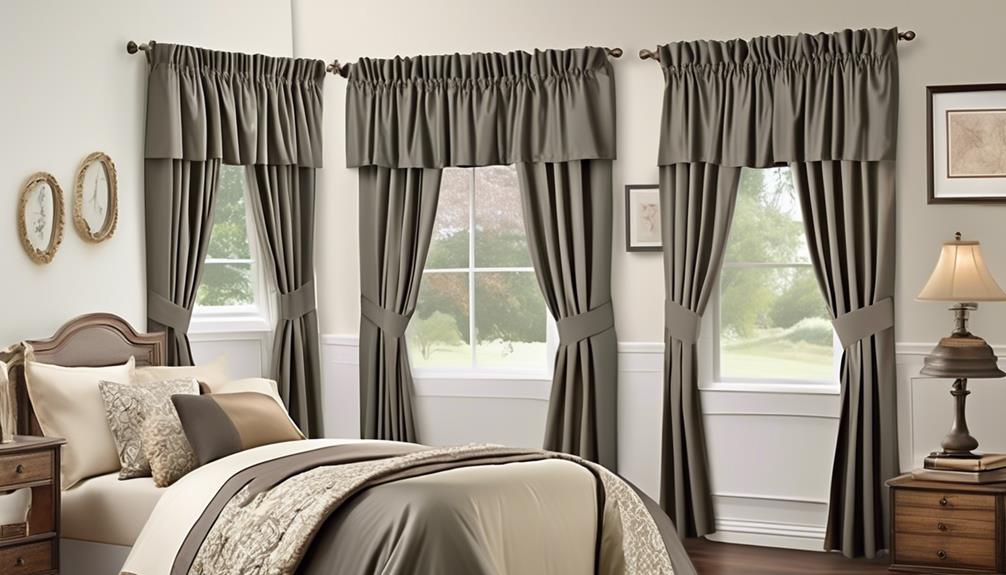
Now, let's explore the diverse range of top of curtain light blockers that seamlessly combine functionality with sophisticated design, enhancing both our sleep environment and the aesthetic appeal of our living spaces.
- Blackout Curtain Liners: These are curtain accessories specifically designed to block light from entering through the top of the curtain. They're typically made of thick, opaque fabric and can be easily attached to the back of existing curtains, providing an effective solution for those seeking to create a completely dark sleeping environment.
- Valances with Light Blocking Lining: Valances not only add a decorative touch to window treatments but can also be equipped with light-blocking lining. This combination of style and functionality allows for the control of light entering through the top of the window while adding an elegant finish to the overall look of the window treatment.
- Top-Down Bottom-Up Shades: These innovative window treatments offer the flexibility to control light from both the top and bottom of the window. By lowering the top of the shade, natural light can be maximized while still maintaining privacy and light control at the top of the window.
These types of top of curtain light blockers not only enhance the functionality of window treatments but also contribute to creating a peaceful and stylish living space.
Factors to Consider When Choosing
When selecting a curtain light blocker, it's essential to consider factors such as the level of light control needed, the aesthetic impact on the room, and the compatibility with existing window treatments.
Material options play a crucial role in the effectiveness of the light blocker. Thicker, heavier materials like velvet or suede offer superior light-blocking capabilities, making them ideal for bedrooms or home theaters where complete darkness is desired. On the other hand, lighter materials such as linen or sheer fabrics provide a gentle filtering effect, allowing some natural light to illuminate the room while still offering privacy.
Color choices also contribute significantly to the overall impact of the curtain light blocker. Darker colors like navy, charcoal, or chocolate brown are popular choices for light blockers as they absorb more light, preventing it from filtering through. However, for spaces where a lighter, airy ambiance is preferred, lighter hues like ivory, soft grey, or pastel tones can complement the room's decor while still providing some level of light control.
It's important to consider the existing color scheme and ambiance of the room when choosing the color of the light blocker to ensure a harmonious overall aesthetic.
Installation Tips for Maximum Effectiveness
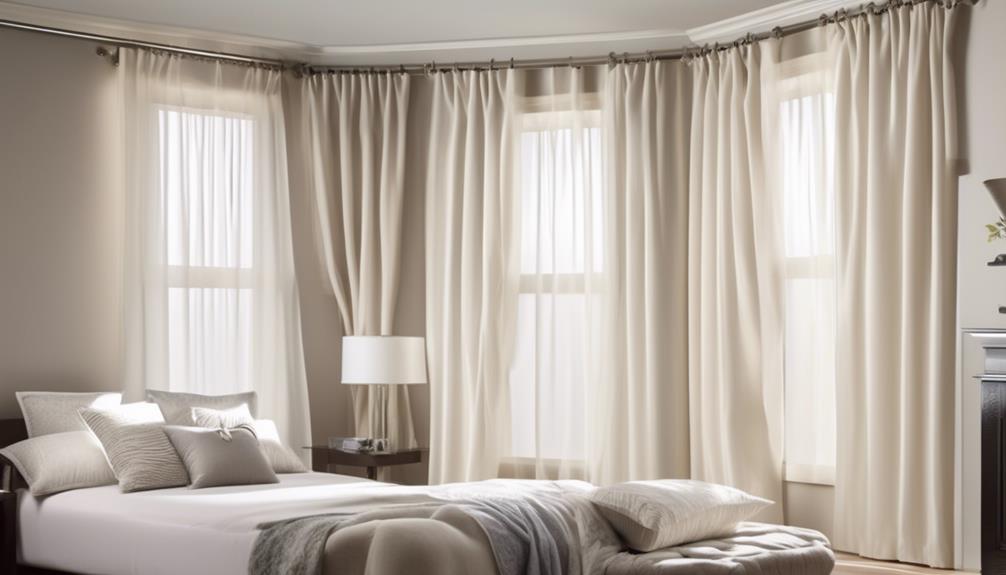
For optimal light-blocking effectiveness, we recommend starting the installation process by carefully measuring the dimensions of your window or doorway. This step is crucial in ensuring that the light blocking materials fit snugly and cover the entire opening, preventing any light leakage.
After obtaining accurate measurements, the following installation techniques will help maximize the effectiveness of your light-blocking solution:
- Proper Mounting: Ensure that the light-blocking materials are securely mounted above the window or doorway to prevent gaps where light could enter. This may involve using sturdy curtain rods, installing tension rods, or securely attaching the light-blocking material to the window frame.
- Overlap and Seams: When using multiple panels or pieces of light-blocking material, pay attention to how they overlap and any seams that may be present. Properly aligning and securing these areas will minimize the potential for light to filter through.
- Sealant and Weather Stripping: In addition to the light-blocking materials, consider using sealant or weather-stripping around the edges of the window or doorway to further block out light and ensure a tight seal.
Maintenance and Care Tips
Regularly inspecting and gently cleaning the light-blocking materials will help maintain their effectiveness over time. When it comes to cleaning tips, it's essential to follow the care instructions provided by the manufacturer. For most fabric curtain light blockers, regular vacuuming with a brush attachment can help remove dust and prevent it from settling into the fibers. For spot cleaning, use a mild detergent and water, but always test it on a small, inconspicuous area first to ensure it doesn't damage the fabric. When dealing with more stubborn stains, professional dry cleaning may be necessary to preserve the fabric's durability.
In addition to cleaning, proper maintenance also involves periodic checks for any signs of wear and tear. Look out for fraying edges, loose threads, or any discoloration that may indicate sun damage. Addressing these issues promptly can help prolong the lifespan of your light-blocking curtains.
Frequently Asked Questions
Are Top of Curtain Light Blockers Effective in Reducing Energy Costs?
Yes, top of curtain light blockers are effective in reducing energy costs.
During installation, we consider material choices and maintenance requirements for optimal energy savings. The installation process is straightforward, and the maintenance is minimal.
These blockers effectively reduce heat transfer and block sunlight, reducing the need for air conditioning and lowering energy costs.
Can Top of Curtain Light Blockers Be Used in Conjunction With Blackout Curtains?
Absolutely! When it comes to light blocker compatibility, you'll find that top of curtain light blockers work seamlessly with blackout curtains.
As for installation tips, make sure to place the light blocker right at the top of the curtain to effectively block out any unwanted light.
This will enhance the effectiveness of the blackout curtains and create a truly dark and peaceful environment.
Do Top of Curtain Light Blockers Help to Reduce Outside Noise?
Yes, top of curtain light blockers can help reduce outside noise. They provide an additional layer of sound insulation, enhancing the effectiveness of your window treatments in creating a peaceful indoor environment.
This privacy solution is a smart choice for interior design, seamlessly blending functionality and style. When seeking mastery in addressing outside noise, incorporating top of curtain light blockers into your space can significantly enhance the tranquility of your home.
Can Top of Curtain Light Blockers Be Customized to Fit Different Curtain Sizes?
Absolutely, top of curtain light blockers can be customized to fit different curtain sizes. We've found that having the ability to tailor the sizing to our specific needs has been incredibly helpful.
The installation options are quite versatile, allowing us to seamlessly integrate the blockers into our existing curtain setup.
This customization ensures a snug fit and maximum light-blocking efficiency, making it an essential addition to our home.
Are There Any Safety Concerns With Using Top of Curtain Light Blockers, Such as Fire Hazards?
Safety concerns regarding top of curtain light blockers primarily revolve around fire hazards. It's crucial to ensure that the materials used are fire-retardant and comply with safety standards. Additionally, proper installation and maintenance are essential to mitigate any potential risks.
Regularly inspecting the blockers and keeping them away from heat sources are key safety measures. Understanding and addressing these concerns will help ensure a safe and secure environment when using top of curtain light blockers.
How can I use a coffee mug to block out light at the top of my curtains?
One creative solution for blocking out light at the top of your curtains is crafting with coffee mugs. Simply attach the coffee mugs to the top of the curtains using hooks or clips. The solid structure of the mugs will effectively block out unwanted sunlight, while adding a unique and decorative touch to your space.
Conclusion
In conclusion, choosing the right top of curtain light blocker is like finding the perfect pair of sunglasses on a bright, sunny day. It's essential for creating a comfortable and relaxing atmosphere in your home.
By considering the types, factors, installation tips, and maintenance, you can ensure maximum effectiveness and long-lasting benefits.
So, let's block out that unwanted light and enjoy the cozy ambiance in our living spaces.
- About the Author
- Latest Posts
Introducing Ron, the home decor aficionado at ByRetreat, whose passion for creating beautiful and inviting spaces is at the heart of his work. With his deep knowledge of home decor and his innate sense of style, Ron brings a wealth of expertise and a keen eye for detail to the ByRetreat team.
Ron’s love for home decor goes beyond aesthetics; he understands that our surroundings play a significant role in our overall well-being and productivity. With this in mind, Ron is dedicated to transforming remote workspaces into havens of comfort, functionality, and beauty.
Beginners Guides
Can You Use Water Instead of Milk
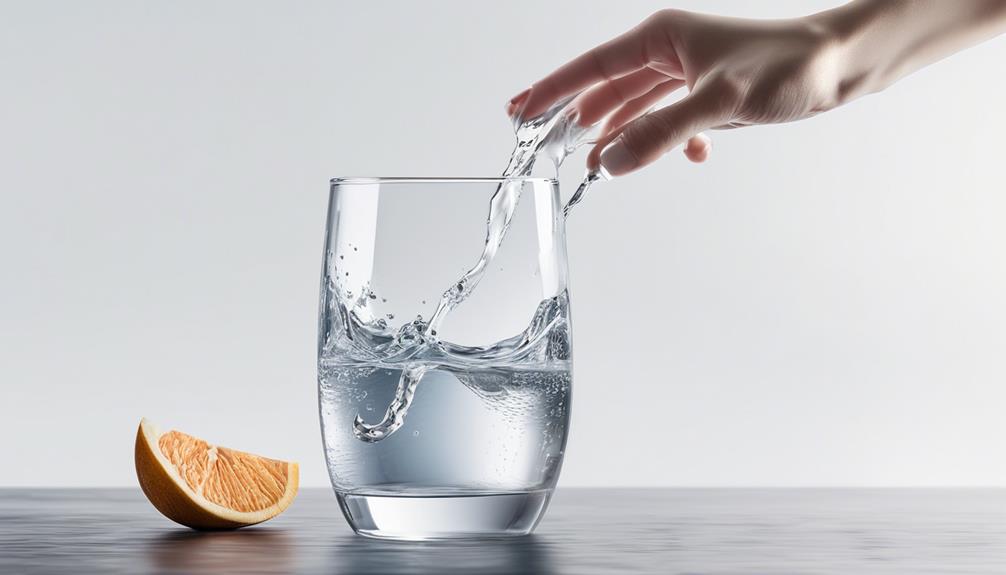
As food enthusiasts, we frequently consider the idea of replacing milk with water in different recipes. But is it a delicious experiment or a risky endeavor?
The decision to substitute water for milk in cooking and baking can be a topic of contention among chefs and home cooks alike. While some may shun the notion outright, others have found surprising success in their culinary creations.
But before we reveal the verdict, let's weigh the pros and cons of this substitution to uncover its impact on flavor, texture, and overall dish quality.
Key Takeaways
- Water is a suitable alternative for individuals with dietary restrictions or lactose intolerance.
- Using water instead of milk can help reduce calorie consumption and is favorable for those monitoring their sugar intake.
- Water can be fortified with essential nutrients, making it a viable option for a balanced diet.
- However, water lacks essential nutrients like calcium, vitamin D, and protein found in milk, which may impact bone health, muscle function, and overall well-being.
Benefits of Using Water Instead of Milk
Using water instead of milk can offer several health benefits, particularly for individuals with dietary restrictions or lactose intolerance. While milk provides essential nutrients such as calcium, vitamin D, and protein, water can be a suitable alternative in certain circumstances.
In terms of health benefits, water is naturally free from cholesterol and saturated fats, making it a heart-healthy choice. Additionally, for those managing their calorie intake, using water instead of milk can help reduce overall calorie consumption, potentially aiding in weight management.
In a nutritional comparison, water is calorie-free and doesn't contain sugar, making it a favorable option for those monitoring their sugar intake. While milk is a good source of calcium and protein, water can be fortified with calcium and other essential nutrients, making it a viable option for maintaining a balanced diet.
It's important to note that while water can offer health benefits, it's essential to obtain nutrients such as calcium and vitamin D from other sources if milk is being replaced. Consulting with a healthcare professional or registered dietitian can help individuals make informed decisions about incorporating water as an alternative to milk in their diet.
Drawbacks of Using Water Instead of Milk
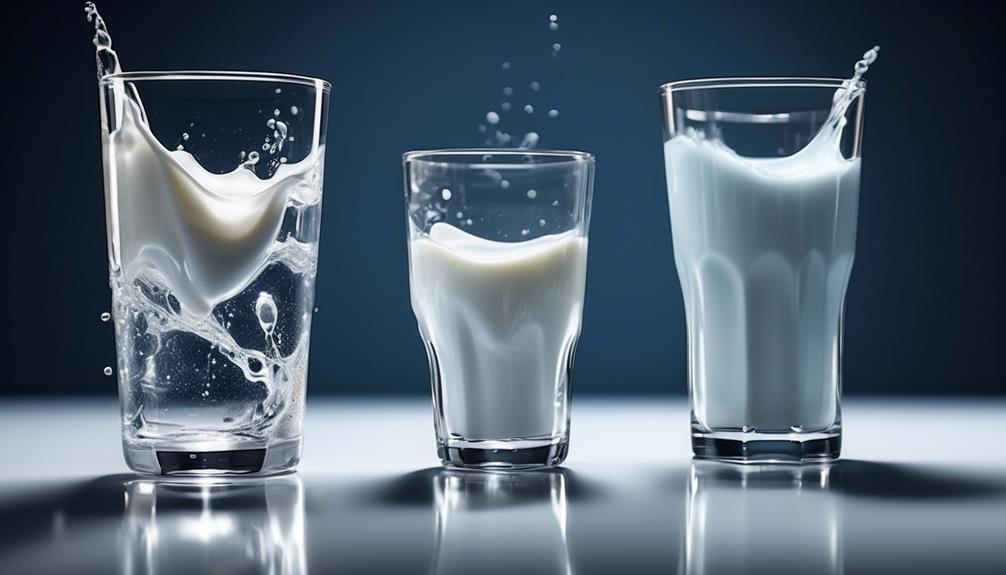
Although water can offer certain health benefits, there are potential drawbacks to using it instead of milk in one's diet. Nutritional impact is one of the primary concerns when considering replacing milk with water. Milk is a rich source of essential nutrients such as calcium, vitamin D, and protein, which are integral for bone health, muscle function, and overall well-being. Water, on the other hand, doesn't provide these essential nutrients, potentially leading to deficiencies if not compensated for in other areas of the diet.
Taste comparison is another significant drawback. Milk has a creamy and slightly sweet taste, which enhances the flavor of various dishes and beverages. When water is used instead of milk, the absence of the creamy texture and natural sweetness may lead to a less appealing taste in recipes such as smoothies, oatmeal, and baked goods.
Considering these drawbacks, it's essential to weigh the nutritional and taste implications before substituting water for milk in your diet. While water has its benefits, it's crucial to ensure that essential nutrients provided by milk are adequately replaced to maintain a balanced and wholesome diet.
Tips for Substituting Water for Milk in Recipes
In recipes, replacing milk with water can be achieved by adjusting the liquid component to maintain the desired consistency and texture. Here are some tips for substituting water for milk in recipes:
- Consider the Flavor Impact: When using water instead of milk, it's important to consider the impact on the overall flavor of the dish. Water may dilute the flavor compared to milk, so you might need to adjust other ingredients or add flavor enhancers to compensate.
- Adjust for Texture: Milk contributes to the richness and creaminess of many dishes. When substituting water, consider how this might affect the texture of the final product. You may need to make adjustments to maintain the desired texture.
- Be Mindful of Nutritional Differences: Milk provides important nutrients such as calcium and protein, which may be lacking when using water. Consider the nutritional impact of the substitution, especially if the dish is a significant part of your diet.
- Experiment and Adapt: Different recipes may react differently to the substitution of water for milk. It may require some experimentation and adaptation to achieve the desired results.
- Seek Alternative Substitutes: In some recipes, alternatives such as nut milk or soy milk may provide a more suitable substitution for milk, offering a closer flavor and nutritional profile.
When substituting water for milk, it's important to be mindful of the flavor impact, nutritional differences, and to make appropriate adjustments to achieve the desired texture and taste.
Culinary Applications for Using Water Instead of Milk
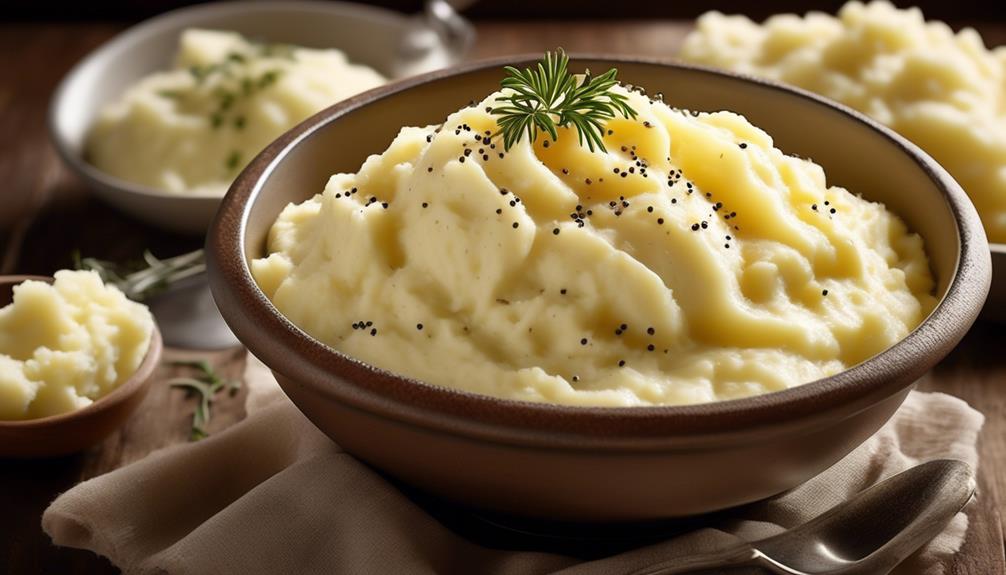
Considering the impact of substituting water for milk in recipes, culinary applications for this substitution can be explored to achieve a range of flavors and textures. When using water in baking, it's essential to consider alternative ingredients that can maintain moisture and richness. For instance, using vegetable oil, coconut milk, or yogurt in place of milk can help preserve the tenderness and flavor of baked goods. Additionally, incorporating flavorful ingredients such as vanilla extract, almond extract, or citrus zest can enhance the taste profile when using water instead of milk.
Flavor considerations are crucial when substituting water for milk in recipes. While water may not contribute the same creamy and rich flavor that milk does, it provides a neutral base that allows other ingredients to shine. When using water in savory dishes, incorporating herbs, spices, and aromatics can elevate the overall taste. In sweet recipes, utilizing high-quality ingredients such as cocoa powder, fruit purees, or nut butters can add depth and complexity to the flavors.
Exploring baking alternatives and carefully considering flavor profiles are essential when using water as a substitute for milk in culinary applications.
Best Practices for Using Water in Place of Milk
When substituting water for milk in recipes, it's important to consider best practices to ensure optimal results in terms of texture and flavor.
- Flavor Considerations: While water can dilute the flavor in some recipes, it can be offset by using high-quality ingredients and boosting flavors with additional spices or extracts.
- Nutritional Impact: Substituting water for milk can significantly reduce the calorie and fat content of the dish, making it a healthier option for individuals with dietary restrictions or preferences.
- Texture Differences: Water lacks the richness and creaminess of milk, so it's important to adjust other ingredients or cooking methods to maintain the desired texture in the final dish.
- Recipe Modification: Some recipes may require adjustments when using water instead of milk, such as increasing the amount of fat or using alternative thickeners to achieve the desired consistency.
- Balancing Act: It's crucial to strike a balance between achieving the desired texture and flavor while considering the nutritional impact of using water in place of milk.
Understanding these best practices will help ensure successful outcomes when using water as a substitute for milk in various recipes.
Frequently Asked Questions
Can Water Be Used as a One-To-One Replacement for Milk in All Recipes?
We can use water as a one-to-one replacement for milk in some recipes, depending on the cooking techniques and recipe modifications.
However, ingredient substitution and culinary experimentation are crucial. In certain dishes, such as soups or certain breads, water can be a suitable alternative.
Yet, it's important to recognize that in recipes requiring the richness and creaminess of milk, water may not yield the desired results.
Are There Any Health Concerns or Nutritional Deficiencies When Using Water Instead of Milk?
When using water instead of milk, there are potential health implications and nutritional deficiencies to consider. Water lacks the essential nutrients found in milk, such as protein, calcium, and vitamins. These deficiencies could impact overall health and wellness.
It's important to consider the nutritional comparison between water and milk to ensure that dietary needs are being met. Making informed choices about ingredient substitutions is crucial for maintaining a balanced diet.
How Does Using Water Instead of Milk Affect the Taste and Texture of the Final Dish?
Using water instead of milk can alter the taste and texture of dishes. In many recipes, milk's creaminess contributes to a richer taste and smoother texture compared to water.
For example, in baking, using water may result in a less tender and moist outcome compared to using milk.
The taste comparison and texture difference between water and milk are noticeable, so it's essential to consider the specific dish and its requirements when making substitutions.
Are There Any Specific Types of Recipes Where Using Water Instead of Milk Is Not Recommended?
In cooking techniques, using water instead of milk may not be recommended for certain baking substitutes and culinary applications.
For example, in recipes that rely on the richness and creaminess of dairy, such as custards or creamy soups, water may not provide the desired texture and flavor.
However, in some dairy alternatives, like certain vegan recipes, water can be a suitable replacement for milk.
Can Water Be Used in Place of Milk in Beverages Like Coffee or Smoothies?
Yes, water can be used as a dairy alternative in beverages like coffee or smoothies. This substitution is becoming increasingly popular due to environmental concerns associated with milk production.
It's interesting to note that by swapping milk for water, individuals can reduce their carbon footprint and water usage.
However, it's important to consider the impact on flavor and texture, as water may not provide the same richness as milk in certain beverages.
Is Water a Suitable Substitute for Milk in Pancake Batter?
When making pancakes with milk, you may wonder if water can be a suitable substitute. While water lacks the creaminess and richness of milk, it can still be used in a pinch. Keep in mind that the texture and flavor of the pancakes may be slightly different when using water instead of milk.
Conclusion
In conclusion, using water instead of milk can be a refreshing alternative in certain recipes, but it's important to consider the potential drawbacks.
While water can provide a lighter texture and subtle flavor, it may not offer the same richness and creaminess as milk.
Like a delicate dance between two partners, the choice between water and milk in cooking requires careful consideration to achieve the perfect balance of taste and texture.
- About the Author
- Latest Posts
Introducing Ron, the home decor aficionado at ByRetreat, whose passion for creating beautiful and inviting spaces is at the heart of his work. With his deep knowledge of home decor and his innate sense of style, Ron brings a wealth of expertise and a keen eye for detail to the ByRetreat team.
Ron’s love for home decor goes beyond aesthetics; he understands that our surroundings play a significant role in our overall well-being and productivity. With this in mind, Ron is dedicated to transforming remote workspaces into havens of comfort, functionality, and beauty.
-

 Vetted3 weeks ago
Vetted3 weeks ago15 Best Contact Paper for Kitchen Cabinets to Elevate Your Home Decor
-

 Vetted1 week ago
Vetted1 week ago15 Best Poe Cameras for Home Security – Reviews & Buying Guide
-

 Vetted4 weeks ago
Vetted4 weeks ago15 Best Leather Restorer Products to Revive Your Furniture and Accessories
-

 Vetted3 weeks ago
Vetted3 weeks ago15 Best Drain Snakes to Unclog Your Pipes Like a Pro
-

 Beginners Guides2 days ago
Beginners Guides2 days agoI Inhaled Vinegar Fumes
-

 Vetted3 weeks ago
Vetted3 weeks ago14 Best Stationery Brands for Your Next Writing Adventure
-

 Beginners Guides2 weeks ago
Beginners Guides2 weeks agoSwinger Porch Light Color
-

 Mardi Gras Decoration3 weeks ago
Mardi Gras Decoration3 weeks agoWhy Does Hobby Lobby Not Do Mardi Gras?




















